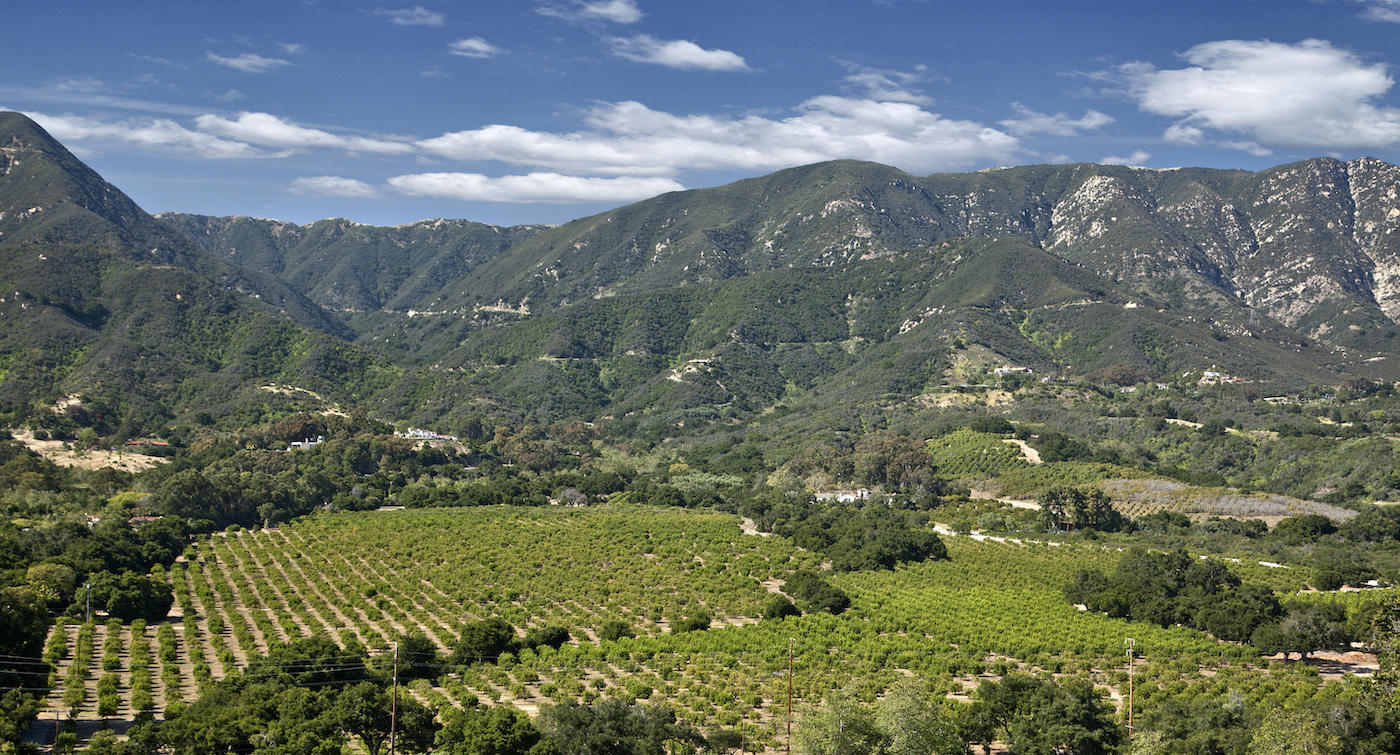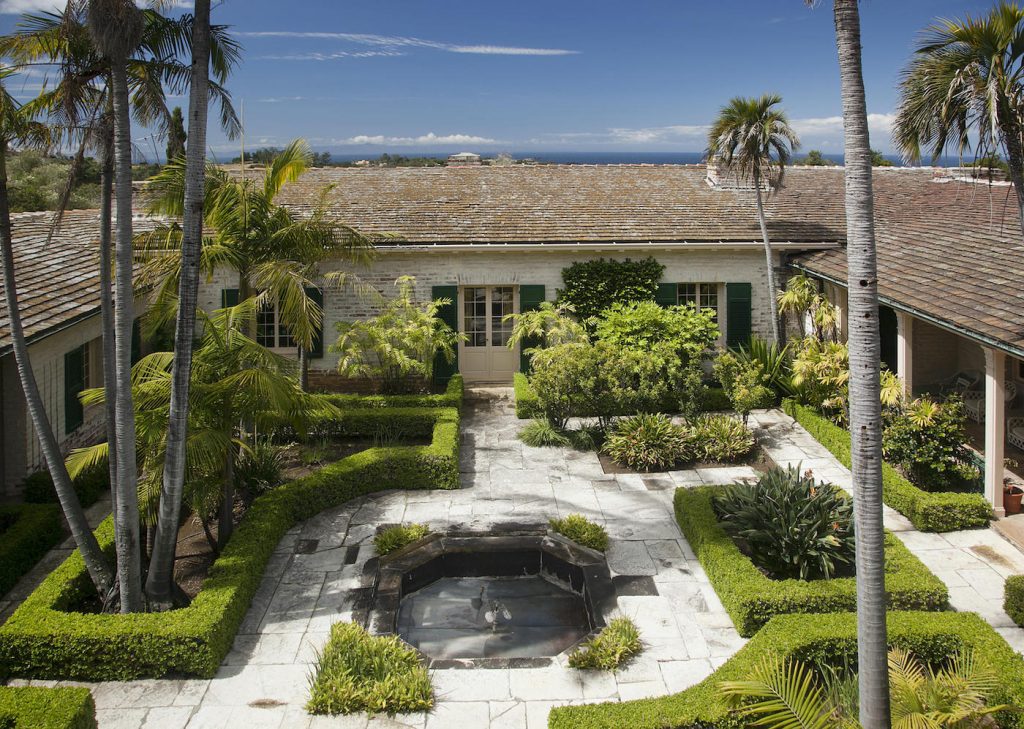HLAC Considers Rancho San Carlos

At a hearing on August 13, the Historic Landmarks Advisory Commission (HLAC) heard from both sides of a contentious third party nomination for historic land marking in Montecito. Rancho San Carlos, the 237-acre property on East Valley Road, long owned by the Jackson family, was being considered for nomination as a Santa Barbara County Historic Landmark at the request of a third party: the East Valley Preservation Association (EVPA).
The EVPA, which comprises an anonymous group of neighbors and Montecito residents who say they are concerned about preserving the semi-rural character of Eastern Montecito, hired Mary Rose to consult on the nomination, which was submitted to the County back in July 2017.
The property, located in the 2500 block of East Valley Road, was purchased by the Jackson family in the 1920s. Original owners Ann and Pete Jackson commissioned master architect Reginald Johnson to build a 29,000-sq-ft main house in a Monterey Revival style, along with other accessory structures. According to the nomination, the estate is a self-contained agricultural and equestrian community, with an office, gate house, shop, greenhouse, kennel, stables, barn, covered riding area, practice polo track, paddock, and staff housing, some of which was also designed by Johnson. The famous architect was well known in Santa Barbara County, designing many buildings in the era, including the Biltmore Hotel.
Rose, in her presentation to HLAC, said the estate satisfies at least six criteria for designation as a Historic Landmark. These include the estate’s reflection of estate development and architectural expression of the time, the fact that the estate was the primary residence as well as horse- and dog-breeding facilities of persons significant in local, state, and national history, and as a reflection of the lifestyle, tastes, and interests of the time period. Other reasons for nomination include the work of Reginald Johnson and master landscape architect Lockwood de Forest, as well as the fact that the estate, which is a combination of citrus orchards, mature habitats, and naturalistic landscaping, has remained almost unchanged for more than 85 years. “It is the last of the great estates; it is well known and very visible,” Rose said, adding that the Jackson family has been great stewards of the property. “Now is the time to act,” she said, noting the estate is currently for sale.
In the 1990s, the property was subdivided into 30 legal parcels, and Rose suggested that incompatible development on the parcels is highly probable after the property sells to a new owner. “The existing buildings could be remodeled or demolished,” she said. “The EVPA is not trying to prevent development or open the property to the public. They are trying to ensure that future development is done in a way that is sensitive to the historic resources that currently create a distinct historic district,” she said. The nomination included proposed special conditions that would prevent development on any portion of the estate until a specific plan for future development of the entire 237 acres has been approved by the County, including HLAC review. The specific plan would be required to preserve the historic character of the estate, including the relationship between residential structures and agricultural and equestrian uses. Public views of the historic structures and orchards would require protection, as well as the character of East Valley Road as a scenic and historic resource. Several other provisions are outlined in the proposal.

Jim Jackson, a descendant of the Jackson family and general manager of the Petan Company, which owns the property, argued against the nomination and questioned the intentions of the EVPA. “Would a group legitimately interested in preservation nominate a property without even talking to the property owner, or without ever having been on the property, or having asked to be on the property during the course of the collection of information for their nomination?” he said, reporting that the family received a copy of the nomination only after it had been submitted already to the County. “This nomination is simply an attempt to use the HLAC to do land use planning, but pretending that the interest is in preservation. But it obviously isn’t,” he said. Jackson asserts that the designation will encumber the sale, costing his family potentially millions of dollars in property value.
Laura Bridley, a planning consultant speaking on behalf of the Jackson Family, dismissed many of Rose’s assertions that the property’s historic resources would not be protected without the Landmark designation. She reminded the HLAC of the stringent review rules placed upon structures more than 50 years old. “To accept the threat by EVPA that unless you nominate the entire 237 acres, everything will be lost or at risk when a new owner buys it, is simply false.”
More than 10 speakers commented at the hearing, the majority asking HLAC to deny the nomination, including Brett Hodges, whose family’s 27-acre property in unincorporated Goleta Valley was up for an unsolicited third-party nomination in 2014; the nomination was denied. “Based on my experience, you can tell when the true motivations of a landmark designation are not to preserve history, but are aimed at preventing any possibility of future development. The clue is that the nomination overreaches and, instead of pinpointing what might be of legitimate historical value, tries to get an entire property labeled as historical. I think it’s pretty obvious this is happening here today with the Jackson property.”
HLAC ultimately denied the nomination unanimously with one abstention, instead voting to form a sub-committee to work with the Jacksons to consider a landmark designation of parts of Ranchos San Carlos, including the barn and main house, and consider contributing factors such as the design of the landscape and auxiliary buildings.
“I cannot support the nomination in its present form, primarily because of the specific condition that it is attached to a development plan. I can see the merit in designating the property. And I also respect the process,” said commissioner Howard Wittausch. Commissioner Randy Melcombe agreed: “Ethically, without the owner’s consent to landmark, I do not feel comfortable land-marking it,” he said, adding that if the Jacksons sell the property to a “destructive buyer,” then HLAC could consider land-marking it at that time.
The decision is appealable to the Board of Supervisors for 10 days following the hearing.





